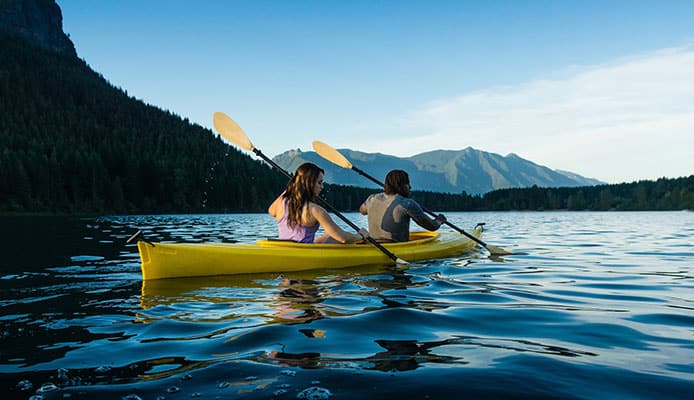
As a less experienced kayaker, you want to do everything you can to perfect your kayaking skills when on your kayak. One of the ways to move up to the next level is to learn how to kayak upstream.
Granted, it is not going to be easy but with practice and determination, it can actually be done. What’s more, it is a great way to exercise your upper body and improve on the paddling skills that you already have.
This is how to do kayaking upstream.
Start with research
The first thing that you need to do before kayaking upstream is to check out the river and research whether it can actually be done. If the water is flowing too fast against you then it can be near impossible to kayak upstream.
When paddling in average flowing waters, the kayaker can travel at a speed of around 3 miles per hour, and sometimes you may even be able to kayak at 6 miles per hour. By studying the river flow, you will be able to judge for yourself whether it’s possible to kayak upstream. Make sure that you have experience and you know how to paddle a kayak.
Also, keep in mind that not all sections of the river will be flowing the same. Some areas flow faster than others. You may find that you will need to choose the slower flowing areas for kayaking upstream.
Watch out for currents and obstacles
Different parts of a river can either help you when paddling upstream or obstruct you. Eddies, for example, are great when you are trying to take a breather and rest a little before continuing upstream. Before heading out into the water, check out the kayaker’s guide to river eddies and whirlpools.
Eddies are simply parts of the river where there is a huge rock or other obstruction which blocks the current and diverts the river. By hanging out behind this obstruction, you can rest before continuing upstream.
You will also want to search for V shape river flows. These can happen both when kayaking upstream and downstream. If you notice an upstream V shape where the shape of the V is pointing upriver, there is a high chance there is a rock ahead that is obstructing the current.
On the other hand, a V shape that points downstream could mean that the water is passing through a funnel-like area. V shapes flows are to be avoided since they cause the water to flow faster.
Remain at the edges
Often the current is weaker near the edges of the river than further out towards the center. If you want to conserve energy then it’s a good idea to kayak closer to the edges.
The more the river is going to narrow the stronger the current is likely to get. This is because the water is being squeezed over a smaller area. You will notice that it becomes much more difficult to paddle against it.
Another way to conserve energy is to get from one Eddie to another using the right kayak paddling technique such as forward paddling. For you to get from one side of the river to the next easily, keep the bow pointing ahead of you but at a slight angle in the direction that you are heading.
Start at a calm section of the river
If it’s your first time kayaking upstream, you will want to start at a slow section of the river. You will gain experience paddling in calm waters before you can take on stronger currents.
You might also like: Kayak And Canoe Oil Canning Guide
Always keep in mind that you are going to expend a lot of your energy paddling upstream than if you are paddling in calm waters. If you are planning on paddling both upstream and downstream then you are starting by paddling upstream then since you will be tired later on, you will need to paddle downstream.
If you started by paddling downstream and then later upstream, you may use up all your energy reserves and be unable to paddle upstream. It’s important to learn how to roll a kayak in case you flip in the water.
Globo Surf Overview
It is possible to kayak upstream against the current as long as you know the river and you are also aware of your own limitations. Always face upstream, watch out for currents and eddies which you can use as resting spots.
Also, watch out for V flows in the river as these will only make your progress upstream that much more difficult. And as you paddle stay closer to the edge.
More Skills Guides:
- How To Lock A Kayak – Keep Your Kayak Safe At Any Time
- How To Tie Down And Transport A Kayak In A Truck Bed
- How To Wax Your Kayak?
- Is Snow Kayaking Possible?
- Kayak Techniques: The Stern Rudder
- Kayak Rescue Guide: The T Rescue
- How To Get Water Out Of A Kayak
- Plastic Kayak Repair Guide
- How To Properly Strap Two Kayaks Into A Car Roof Rack
- How To Roll A Kayak

